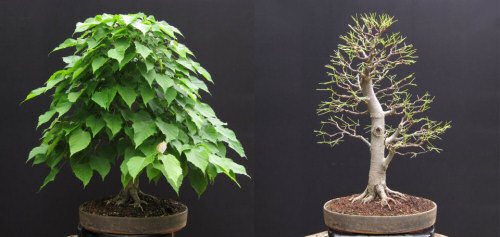Defoliation means removing some or all of the leaves from your tree. Why in the world would one want to do that? After all, your bonsai is trying the very best it can, and that means having lots of nice leaves. A necessary prelude to the subject of defoliation of deciduous trees is a few thoughts about how these trees grow. Every self-respecting tree wants to grow both tall and wide. It does this by extending its branches in all directions. The tree needs energy to do this, which means more leaves. As the branches grow longer, the canopy of leaves form an outer shell around the tree. Side branches underneath the canopy receive less and less light as the tree grows, and as a result, the inner growth slowly dies due to lack of light, leaving bare branches inside the canopy. This process works great for a landscape tree but can be a disaster for deciduous bonsai because it generates ever longer bare branches. So, what can one do about this? As you might have guessed, the answer is defoliation.
Defoliation of deciduous trees has three possible objectives. The first is to allow sunlight to reach into the interior of the tree which will allow continued growth of the small interior side branches, achieving a fuller tree. The second objective is to achieve balance in the tree. This can be useful when a particular branch is growing a little too rapidly for the design of the tree and relies on the fact that the growth of a branch is slowed when the leaves are removed.
A related issue is that outermost leaves of the canopy receive the most light, and they can become significantly larger than the rest of the leaves. Balance of the tree can be restored by removing only these leaves. The third objective is to increase ramification of the tree. After the removal of leaves, the tree sprouts a flush of growth including activation of dormant buds, and this leads to increased branch structure in the tree.
Defoliation can be considered as soon as the new growth has hardened off after spring growth. This means June, or by the middle of July at the very latest. Leaf removal is definitely scissor work. Pulling the leaves by hand is likely to damage buds at the base of the leaves which defeats the whole idea of what defoliation hopes to accomp lish. Leaves are removed by cutting the stalk of the leaf about half way between the blade of the leaf and the branch.
lish. Leaves are removed by cutting the stalk of the leaf about half way between the blade of the leaf and the branch.
Once the tree has been defoliated, careful management of water is needed. Water normally flows from the soil through the trunk to the leaves where much is then lost by evaporation. If the tree has been defoliated, this water is no longer lost until the new leaves grow, hence the drain of water from the soil is less. All this means that it is easy to overwater defoliated trees. On the other hand, of course be sure that the tree does not dry out. The trunk and roots have been shaded by the leaf canopy and if this is suddenly removed, they are exposed to possible burns by full sunlight. A defoliated tree can be either moved into light shade until the new leaves form, or the trunk and roots can be protected by a towel.
You may wish to only slow the growth of a branch, but do not wish to encourage activation of the buds on the branch. In this case, the leaf itself is trimmed back by about one half of the area of the leaf rather than cutting the whole leaf off.
A requirement for any tree before defoliation can be considered is that the tree be in robust good health. If the tree is weak, loss of all the leaves could prove to be fatal. Some trees are much better candidates for defoliation than others. For example, Japanese maples are not thrilled by the idea of defoliation and total defoliation is not a good idea. On the other hand, the gold standard for defoliation is the trident maple which can, with care, be defoliated as many as three times a year. If you are not sure about your tree and there seems to be no advice available, best to only partially defoliate and see how the tree does. If it survives in good humor, more drastic measures can be considered next year.
Pines as well as deciduous trees are also defoliated. Pines are a special case because we usually do not think of needle pulling as defoliation but it really is because the needles actually are leaves. The needles are pulled for two reasons. Needles older than a couple of years are no longer producing energy for the tree and, worse, are a drag on the energy of the tree. Needles have at their base buds which can become active and grow when the needles are removed. Pines operate on a much longer time scale than deciduous trees. The fact that the needles are at least two years old before they are removed is what makes pine distinctly different from deciduous trees which naturally defoliate themselves every fall. For defoliation to have any effect on deciduous trees, it has to happen only a few months after the tree leafs out in the spring.
Defoliation is a powerful technique for creating a fine well-ramified bonsai with lush and full growth. We should all have this as a tool in our arsenal of bonsai management.

